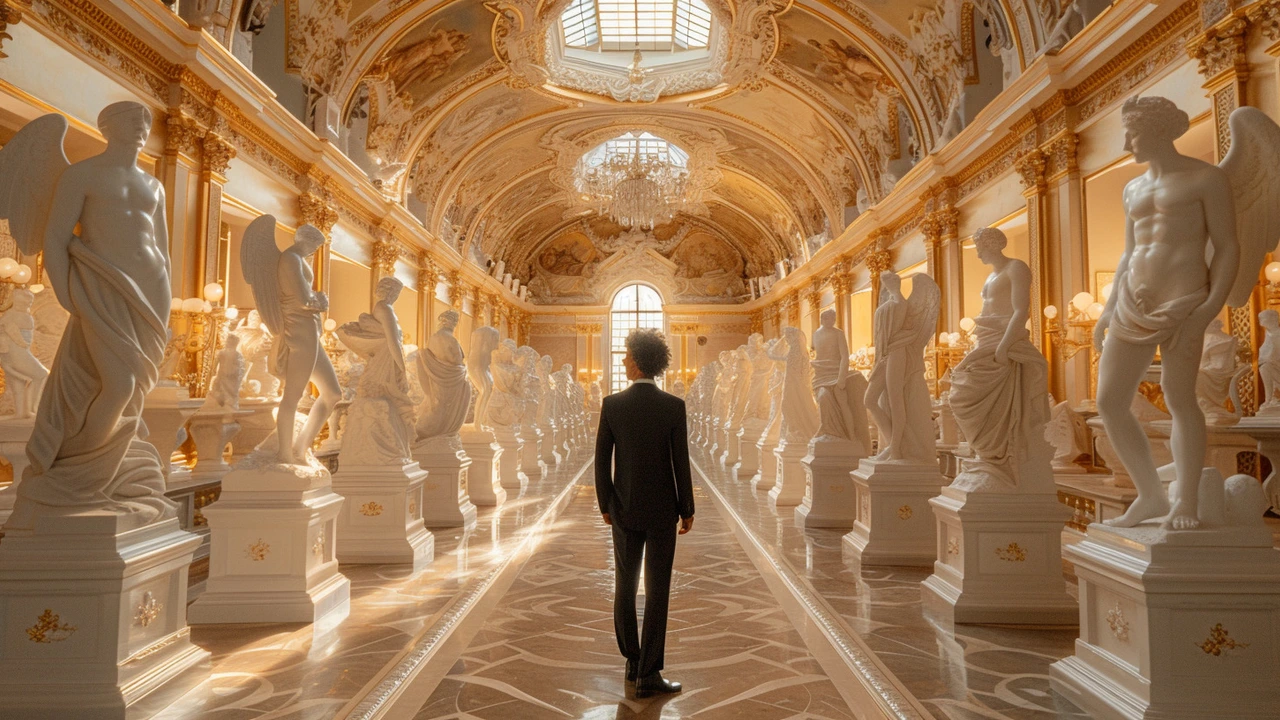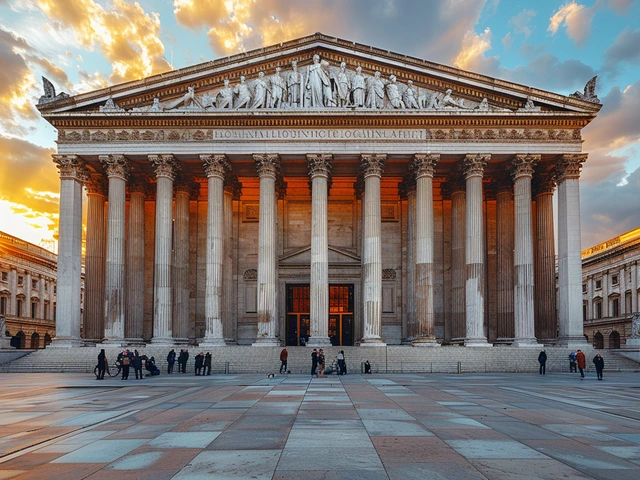Discovering Classicism: A Journey Through Time
Oh, classicism! It's like that one friend who never ages, always draped in a white toga, probably humming some Vivaldi while casually discussing philosophy or opining on the virtues of Roman architecture. I find its timeless appeal absolutely remarkable and it's quite amazing how its principles are still relevant today, as fresh as my Golden Retriever Cisco dashed out of the bath—wet, but, you know, timelessly classic in his own doggy way.
Let's embark on a little journey through time and try to untangle what classicism actually is. At its core, classicism refers to a reverence for the classics, and by classics, I mean those venerated works of art, literature, philosophy, and architecture stemming mostly from Ancient Greece and Rome. As a man who gets excited by history books more than is probably healthy, I've come to appreciate that classicism isn't just a style; it’s a way of thinking. It champions harmony, clarity, balance, and proportion, values that can give today's world of chaotic trends and fads a grounding hug.
How did classicism come about, you ask? Well, if we hop on our historical time machine and zip back to the Renaissance period, that's where you'll see it resuscitate after a long snooze in the Middle Ages. Renaissance folks, they were kind of the hipsters of their time, adored the ancient knowledge and oozed nostalgia for the 'good ol' days' of Greece and Rome. Artists like Leonardo da Vinci and architects like Andrea Palladio were throwing classicism-themed parties, breathing new life into the ancient styles and principles, and frankly, they nailed it.
I can't help but be fascinated by how these ideas traveled through time, popping up throughout various historical periods. Each era's take on classicism was like a cover song with a twist, from the Baroque to Neoclassicism, all insisting on adding their own riffs onto the original melody. Think of it as remixing a Beatles song – it's the same tune, but with an '80s synth-pop flair. And who doesn't enjoy a good remix?
Classicism has also been like a trusty blueprint in Western education. If you're wondering why you had to wear a toga for that one weird play in school, blame classicism. It's been a huge influence in shaping curriculums. I mean, not every day you hear a six-year-old like my son Sebastian using the word 'coliseum'—but that's what happens when your bedtime stories often take a detour through Ancient Rome. I'll confess it's partially just to make baths less appealing to him compared to gladiator stories. Grace always smiles and rolls her eyes at this; her patience must be a classic virtue too.
Why Classicism Still Captivates
Alright, let's dig into why classicism hasn't just stuck around, but continues to captivate us, like that catchy tune that you just can't get out of your head. At its heart, classicism embodies a kind of universal beauty and wisdom that seems to transcend time itself. Can you imagine anything more human than gazing up at the Parthenon or reading a passage from Homer and feeling that immediate connection to the past? It's like chatting with a forefather on a family reunion—assuming that forefather is a marble statue that's really into togas.
But it's not just about nostalgia. Classicism carries with it an air of order and stability, which can be oh-so-comforting in our fast-paced, often tumultuous world. When everything around us feels as reliable as a chocolate teapot, classicism is there offering a solid, perfect proportioned port in the storm. And let's face it, its aesthetics are downright pleasing. There's a reason we haven't bulldozed the Roman Colosseum to make way for a car park—it's because it still looks awesome, and nobody can resist an epic background for their selfies.
Now, classicism isn't just a treat for the eyes. It's grounded in philosophy and ethics too, stuff like virtue, citizenship, and the good life—themes that are surprisingly relevant when you’re trying to instill good values in your kids or pondering over the latest news headlines. Sometimes, I chat with Grace about how Socrates or Seneca might tackle modern dilemmas, leading to lively dinner debates. Just imagine, discussing geopolitics over lasagna with a sprinkle of ancient wisdom—that's one flavor combination I bet nobody saw coming!
In addition, classicism teaches us the importance of balance. And no, I don't mean trying to balance your budget while dreaming of a vacation under Tuscan sun. More like finding a middle way or the 'Golden Mean' of Aristotle, addressing life’s challenges not with excess or defect but with moderation and common sense. It's not just good advice; it's practically a life hack that never gets outdated.
Classicism in Modern Life
Now, you might be thinking, "Sure Malcolm, all this sounds great, but what does it have to do with modern life?" Well, you'd be surprised by how often you encounter the whispers of classicism on a daily stroll or while binge-watching a new TV series. You know those impressive government buildings with columns that make you feel like you're entering Solomon's temple? Classical architecture, my friend. Or how about those logos with little laurel wreaths or the fashion trends that hark back to Greek and Roman silhouettes? Yup, classicism's fingerprints are all over them.
And it's not just aesthetics—it's philosophy, knowledge, and storytelling too. The notions of democracy, republicanism, and legal systems—quite a chunk of these abstract buildings where modern society resides were designed using the classical blueprint. Then there's every college student's favorite pastime, referencing classics in literature essays, because nothing quite gives an argument an air of sophistication like quoting Plato—trust me on this; I've lived it.
Also, think about our entertainment. Movies set in ancient times, books exploring mythologies, video games that let you build empires or even go toe-to-toe with a Minotaur—these are all drenched in classicism sauce. Trust me; I've mistaken Cisco's bark for Cerberus' growl more than once after a long gaming session. It’s entertaining, yes, but it's also educating us, keeping classicism's influence alive and inviting us to continuously question and learn from the past.
Even in the ways we reason and communicate, you can see classicism's impact. Ever been wowed by a well-crafted argument or speech? That's likely due to the classical rhetorical techniques employed—the very ones Cicero would have given a standing ovation for. It's all about the art of persuasion, and if you've ever tried convincing a toddler to eat broccoli, you'll know just how valuable that art can be.
Unpacking the Principles of Classicism
To really get our heads around the allure of classicism, we've got to unpack its principles. It’s like dissecting a fine wine or a carefully crafted lasagna—there are layers to savor. Symmetry is one such principle, and it’s about as vital to classicism as breathing is to, well, not being a statue. Symmetry resonates with us, probably because we see it in ourselves every time we look in the mirror. Unless you're like me, making funny faces at Sebastian to make him giggle, and then all bets are off.
Then there's order. Much like how I need to keep Cisco’s toys from becoming living room landmines, classicism appreciates an orderly approach to design and thought. Structures built on classicist ideas have a clear, logical organization, a calm reliability that says, "Hey, no need to panic, everything is where it should be." Considering my last attempt at DIY shelving, I definitely have some lessons to learn from classicism on that front.
Proportion is another hallmark of classicism. Just as there's an ideal ratio for the ingredients in Grace's incredible cookies (which I'm still trying to sneakily discover), classicism values the balance and the 'rightness' of scale. This principle teaches that the whole can only be perfect if every part is in the correct relation to one another. No wonder classicism is pretty much the Marie Kondo of aesthetics—it sparks joy by making everything fit just right.
And how could we forget clarity? Classicism despises confusion as much as I despise finding a piece of Lego with my bare foot in the dark. Art and architecture influenced by classicism strive for clear, precise expression, offering up their beauty and truth without the frills and frippery. It's about communicating directly and effectively, which in our age of information overload, is more refreshing than ever.
Classicism in Art and Architecture
Now, if we narrow our focus onto art and architecture, prepare to be wowed because classicism has quite the portfolio. From Michelangelo’s David, which is the marble embodiment of humanistic values, to the Pantheon with its gaping oculus as if to say “look at me, I’m still standing” to every millennial passing by—it’s impressive, to say the least.
Classical art is characterized by its attention to details and its love for idealized forms. There's a serenity to it, like how Cisco looks when he's finally napping after a marathon of fetch. Artists were obsessed with capturing not just physical perfection, but moral dignity and nobility. There was no snapping a quick selfie; these works demanded time, precision, and a dab of the divine. Now, I'm no Michelangelo, but I’ve tried my hand at drawing and, let's just say, Cisco’s likeness on paper often looks more... mythical beast than golden retriever. But hey, we love our mythical beasts, don't we?
As for architecture, classicism shows off its love for columns, domes, and pediments, almost like a fashionista flaunting the hottest trends—but, you know, trends that have lasted for millennia. These buildings carry an aura of grandeur and authority, an architectural confidence that says, “I’m not just any old building; I’m a statement.” And they truly are. They invite you to pause, look up, and ponder on the grand scheme of things, even if just for a moment before you trip on the cobblestones—I’ve learned that the hard way.
Moreover, classical architecture teaches us that a building can both be a functional shelter and a work of art. It's this marriage of utility and beauty that lures us in, making us feel like we're part of something larger than life itself—like the way Grace looks at our home after I’ve finally finished cleaning and everything is in its place, a rare and beautiful alignment of the stars (and sofa cushions).
Classicism's Influence on Society and Culture
As we wrap up our exploration of classicism, let's consider its broader influence on society and culture. It’s like examining a family tree and discovering you’re related to Newton or Cleopatra—it’s kind of a big deal. For starters, the influence of classicism on Western thought can’t be overstated. It shaped philosophies, legal systems, and educational models. It encouraged us to think critically, debate ideas, and aspire to civic virtues. When I help Sebastian with his homework, I can glimpse those threads of classical thought, and honestly, it’s grounding.
Classicism has also been a wellspring of inspiration across creative fields. We see its themes and forms woven into novels, plays, and even modern-day cinema. Directors like Stanley Kubrick didn’t just tip their hats to classicism; they embraced its tenets wholeheartedly. Remember those epic scenes in 'Gladiator'? Quintessential classicism at its cinematic best. It grabs you by the toga and immerses you in a world where principles and aesthetics collide dramatically.
Moreover, classicism continues to influence modern design—from skyscrapers that echo the discipline of classical proportions to consumer products that emphasize symmetry and harmony. It's that little touch of time-honored elegance that makes things feel 'just right.' Even when you swing open a new gadget’s box or step into an elegantly designed car, you are, in a way, experiencing the ripples of classicism’s deep pool.
In the realm of culture, classicism serves as a connecting thread, tying the present to the past. It reminds us of humanity’s shared heritage and prompts us to preserve the wisdom of ancient times. Whenever I visit a museum or explore heritage sites, I'm struck by how classicism has become a cultural custodian, safeguarding stories and lessons across generations. It's empowering, really, to think that by honoring these traditions, we are contributing to a legacy that will outlast us all.
So, there you have it—a hearty dive into the world of classicism and its timeless appeal. Whether it’s a walk through history, an appreciation for enduring beauty, or simply the quest for a little balance and order in our lives, classicism has something to offer. And the best part is, it's everywhere, waiting to be appreciated. Just like old-school values in a modern world, classicism doesn’t scream for attention; it stands dignified, whispering tales of a bygone era that somehow still feels close to home.
Thank you for strolling down this marbled, column-lined memory lane with me. Now, if you’ll excuse me, Cisco is giving me that “time for a walk” look with his big, puppy-dog eyes, and I'm preparing to step out into the modern world that, thanks to classicism, holds onto beauty forged in antiquity. Go on, give classicism a little nod next time you see it around—trust me, it's got plenty to share.



